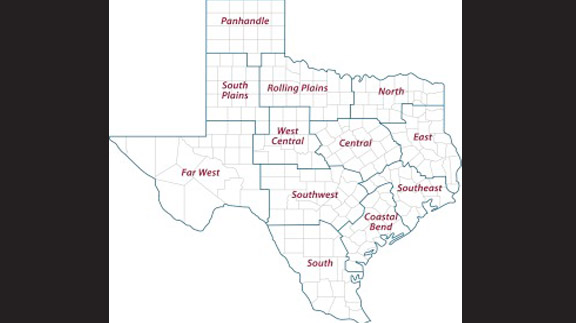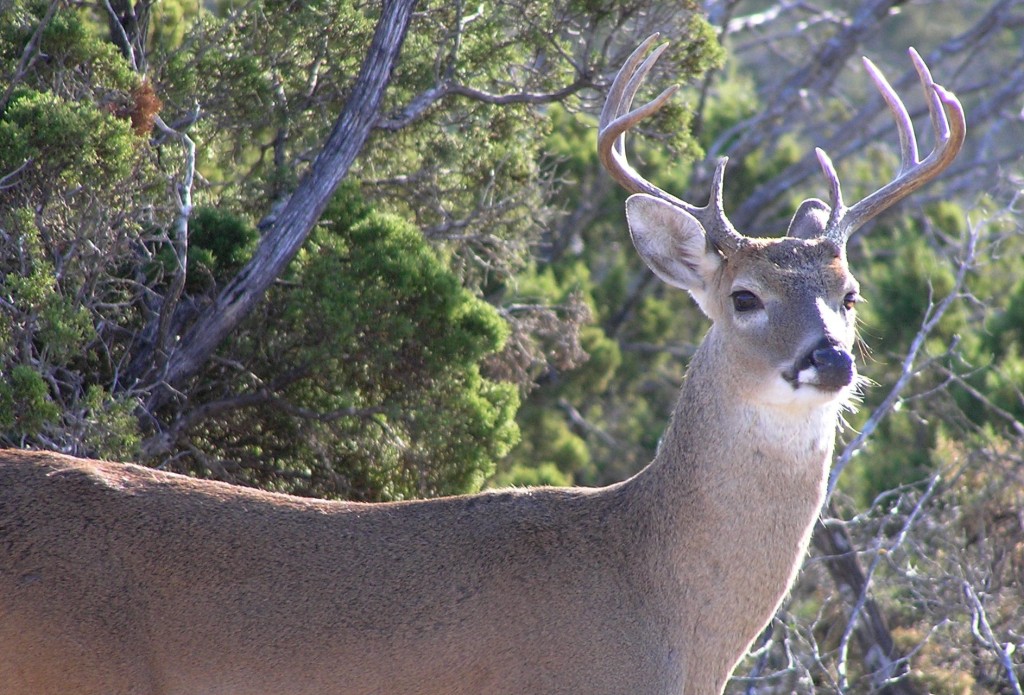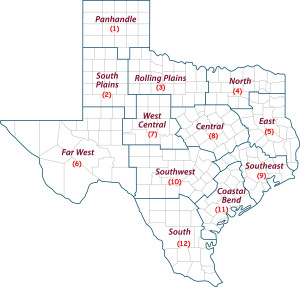Farm & Ranch
Texas crop, weather report for Nov. 24, 2015

By: Robert Burns
AgriLife Expert: 2015 is ‘jubilee’ year for deer hunting
Writer: Robert Burns, 903-834-6191, [email protected]
COLLEGE STATION – Thanks to plenty of rain at the right times, the 2015 hunting season has been a “jubilee year” for the white-tailed deer crop, according to a Texas A&M AgriLife Extension Service wildlife specialist.
“The deer crop this year has been fantastic,” said Dr. Jim Cathey, AgriLife Extension wildlife and fisheries program leader at College Station. “There are a lot of happy hunters out there.”
Download or preview a two minute MP3 audio version of this report
The economic impact in Texas for hunting was $3.65 billion in 2011, a drought year, and the most recent year for which he has statistics, Cathey said.
“Of that, deer hunting alone counts for $2.16 billion,” he said. “So it’s a pretty important economic driver for our state and wildlife conservation in Texas.”
Cathey noted that it’s been a very good year for other types of hunting, particularly quail, as numbers are back up.
Cathey noted that because 2011 was a drought year, which meant poorer crops of deer and other game animals, he would expect the economic impact for this year to be better.
“We should probably have brand new numbers within a year,” he said. “But I can’t say they will be higher because everything depends on license sales and related items. But drought or not, it’s definitely worth getting the license, not only for the importance of going out there and enjoying wildlife recreation but for the contribution the hunter conservationist makes back into the management of wildlife.”
AgriLife Extension district reporters compiled the following summaries:
Central: Crops, soil moisture, rangeland, pastures and livestock were all rated as being in good condition throughout the region. However, in many areas saturated soils were expected to delay wheat planting another 10 to 14 days. Stock-water tanks were full. Some producers were still harvesting cotton. Some corn and forage silage still needed to be harvested as well. Growing conditions remain good. The condition of pecan crops remained mixed.
Coastal Bend: The region received more rain, which was welcome as it fortified soil moisture levels going into winter. Winter pasture planting was completed. Some producers were applying fertilizer on drier fields. The first frost occurred in the northern portion of the reporting area. The pecan harvest continued, with good yields in improved orchards. Livestock market prices dipped. Cattle were in good condition.
East: The region received from 1 inch to 3 inches of rain, saturating already wet fields and causing flooding in some areas. Henderson County producers had to contend with flood-related issues on roads, fences and corrals. However, the moisture and cooler temperatures improved winter forages. Some producers were seeing slow growth of forages due to delayed planting caused by the dry weather in mid-October and early November. Some areas reported the first freeze Nov. 21-22, which caused warm-season grasses to finally enter dormancy and allow cool grasses to grow. Cattle were mostly in good condition. Producers were supplementing livestock with feed and hay. Hay quality was poor. Most spring-born calves were marketed. Fall calving was in progress. Marketing of cull/market cows continued. Feral hogs continued to be a problem in many areas.
Far West: The entire region had warm days with cool to cold nights. El Paso County had its first freeze, which sped up the opening of pecan shucks. The freeze also sent onion and alfalfa crops into dormancy. Ward and Culberson counties had rain showers. High winds from passing of cold fronts dried out topsoils but also increased high wildfire danger. Cotton harvest proceeded at full tilt and was expected to be finished soon. Farmers continued sowing winter wheat and already emerged fields looked good — with the exception of a few areas where soils were deficient in nitrogen due to standing water. Producers were wrapping up fall cattle work, with some cull cows being shipped and others being fattened up for sale early next year. Pastures were green with winter weeds. Trees, except for mesquite, were starting to turn color. Topsoil and subsoil moisture remained adequate.
North: Topsoil moisture varied from adequate to surplus. Some areas received from 0.5 inch to 2 inches or rain. Wheat fields and pastures were wet and muddy. Wheat stands were rated as fair to average, but late planting due to dry conditions delayed grazing. Warm-season grasses in rangeland and pastures conditions were declining due to colder weather, but winter grasses and legumes were coming on. Many ranchers were starting to feed hay and provide some supplemental protein. Livestock were in good condition. Wild hogs were active.
Panhandle: Temperatures were near average. Severe weather early in the reporting period brought rain, hail, high winds and tornados to some areas. Soil moisture continued to be rated mostly adequate. Collingsworth County cotton yields continued to be average to above average, but grades were coming in low. Much of the irrigated cotton crop was harvested. Deaf Smith producers had all but wrapped up harvesting of corn, most grain sorghum and hay. The winter wheat crop there was looking good despite some disease issues already appearing in early planted wheat. Producers continued planting some wheat behind late corn and some harvested sorghum fields. Manure spreading and fertilizing for next year was ongoing. Stocker cattle were being placed on wheat pasture in increasing numbers. Gray County had tornados. Hansford County rain slowed down cotton harvesting, but early reports indicated quality will be lower than anticipated. Lipscomb County had storm damage in some areas. In Moore County, the grain harvest was almost completed, while the cotton harvest continued in full swing. Randall County had an early taste of winter weather with 60 mph winds all day on Nov. 16. Fieldwork was delayed due to about 1 inch of rain and the extremely windy conditions. Wheeler County ranchers were providing supplemental protein to cow herds. A killing frost allowed cotton producers to begin harvesting if they had not utilized defoliants. Wheat was improving with recent moisture.
Rolling Plains: Some areas received from 0.5 to 1 inch of rain. Wheat planting continued where possible under largely favorable but wet conditions. Some areas were about 70 percent planted. The cotton harvest was delayed by wet field conditions but should was expected to resume by Thanksgiving. Rangeland, pastures and livestock were in good condition. Producers were able to put only limited numbers of stocker calves on earlier-planted wheat pastures due to wet conditions and late planting.
South: The region continued to have warm days and cool nights. No rainfall was reported anywhere in the region. Soil moisture was adequate throughout the region. In the northern part of the region, harvesting of peanuts continued. Armyworms were found in winter forages, and the first freeze of the year occurred over the weekend of Nov. 21-22. Wheat and oats were planted, with the most fields already emerged. Forage quality continued to improve, and less supplemental feeding of beef cattle herds was required. In the eastern part of the region, beef cattle producers were actively marketing calves and culling cows prior to winter. Rangeland and pastures remained in good condition. In the western part of the region, spinach harvesting was active, with the cro in different stages of maturity throughout the area. Baby-leaf spinach harvesting for the fresh market was particularly active. Cabbage crops also made good progress. With good grazing available, livestock on native range and pastures continued to do well. No supplemental feeding was needed. Onions progressed well, and oats and wheat emerged and were making good progress. In the southern part of the region, sugarcane harvesting was underway in Hidalgo County. Fall vegetable crops progressed well in Starr County. Rangeland and pastures remained in good condition throughout the area.
South Plains: Many areas had their first hard freeze along with some rain. Floyd County received 0.5 inches of rain and very high winds early in the week, which kept farmers out of fields for a day or two. Otherwise, they continued to wrap up the cotton and grain harvests. Most expected to finish by Thanksgiving. In Cochran County, soils were drying out from lack of moisture and high winds. The cotton and grain sorghum harvests were ongoing. Producers were still planting winter wheat. Pastures and rangeland were in good condition. Lubbock County received rain on Nov. 16. Amounts varied, with heavier rain on the eastern part of the county. The city of Slaton got 0.9 inches. A killing freeze was finally registered for Lubbock: 28 degrees on Nov. 21 and 25 degrees on Nov. 22. Harvest and ginning were proceeding well. Stocker cattle on wheat pasture look good. In Garza County, cotton harvesting continued despite 0.3 inches of rain early in the week. Fields dried out within a couple of days thanks to moderate winds, and harvest resumed. Rangeland and pastures were mostly in good condition. Producers provide supplemental feed to cattle in areas that had been more intensively grazed and on the days where temperatures were below freezing. Scurry County also reported their first freeze on Nov. 23. Winter pasture planting was completed.
Southeast: Soil-moisture levels throughout the region varied widely, but were mostly in the adequate to surplus range, with adequate being the most common. Walker County reported 100 percent adequate soil moisture. Rangeland and pasture ratings were mostly fair to good, with fair ratings being the most common. After recent rains, Waller County pastures were looking much better. There were some reports of armyworm activity in small grain winter pastures. Brazoria County had standing water in fields. Chambers County also had very wet conditions. Most fieldwork may be delayed until spring by the wet soils.
Southwest: The pecan harvest continued, and farmers were still planting winter crops as temperatures began to fall. Livestock were in fair condition. The deer hunting season has been one of the best in many years, with quality antlers and great deer movements. Pastures were improving.
West Central: The region had mild days with cold nights. Some areas had their first light frost. A few areas received isolated showers. Soil moisture was rated as good in most counties. The cotton harvest continued, with about half of the crop out of the fields. Irrigated cotton yields were good, and dryland yields fair. Quality grades decreased due to the wet conditions. Winter wheat was off to a good start thanks to the recent rains. No insect problems were reported. Producers continued to plant winter wheat behind cotton harvesting. The sesame harvest began. Range and pasture were in great condition and providing some grazing. Winter weeds and grasses were also coming on strong. Livestock were in fair to good condition going into winter. Cattle prices were still holding steady. The pecan harvest was underway.
-30-
Find more stories, photos, videos and audio at http://today.agrilife.org
Farm & Ranch
Acorn Toxicity

By Barry Whitworth, DVM, MPH
With the prolonged drought, most pastures in Oklahoma end up in poor condition. With the lack of available forage, animals may go in search of alternative foods.
If oak trees are in the pastures, acorns may be a favorite meal for some livestock in the fall. This may result in oak poisoning.
Oak leaves, twigs, buds, and acorns may be toxic to some animals when consumed.
To read more, pick up a copy of the November edition of North Texas Farm & Ranch magazine, available digitally and in print. To subscribe by mail, call 940-872-5922.

Farm & Ranch
Silver Bluestems

By: Tony Dean
There are a handful of grasses on North Texas grazing lands ranchers need to know, not because they are highly desirable, but rather because they are not of much value. I call them “decom” plants, which is am acronym for “Don’t Ever Count On Me.” Silver bluestem is a “decom” grass.
Silver bluestem is a perennial which grows in all areas of Texas. It can survive in almost all soil types, and in full sun conditions or in semi shade. It grows up to three feet tall and is easily recognized with the presence of the white fuzzy seed head. Also, one of the identifying characteristics of Silver bluestem is a bend in the stems at each node, causing the plants to take on a rounded shape as they mature.
To read more, pick up a copy of the November edition of North Texas Farm & Ranch magazine, available digitally and in print. To subscribe by mail, call 940-872-5922.

Farm & Ranch
Meanwhile Back At The Ranch

By: Rayford Pullen
Fall is here which means winter is closing in on us and before we officially get into winter, we need to make sure our factories are either producing or will be producing in a few months.
We have been pregnancy testing our cows this fall and if they are not bred or nursing a calf, we are bidding them adios. With annual costs somewhere between $900.00 and $1,000.00 per cow, those cows not producing a live weaned calf are costing us quite a bit.
To read more, pick up a copy of the November edition of North Texas Farm & Ranch magazine, available digitally and in print. To subscribe by mail, call 940-872-5922.
-

 Country Lifestyles2 years ago
Country Lifestyles2 years agoScott & Stacey Schumacher: A Growth Mindset
-

 Country Lifestyles8 years ago
Country Lifestyles8 years agoStyle Your Profile – What your style cowboy hat says about you and new trends in 2017
-

 HOME8 years ago
HOME8 years agoGrazing North Texas – Wilman Lovegrass
-

 Equine1 year ago
Equine1 year agoThe Will to Win
-

 Country Lifestyles5 years ago
Country Lifestyles5 years agoAmber Crawford, Breakaway Roper
-

 Outdoor9 years ago
Outdoor9 years agoButtercup or Primrose?
-

 Country Lifestyles8 years ago
Country Lifestyles8 years agoJune 2016 Profile – The man behind the mic: Bob Tallman
-

 Country Lifestyles8 years ago
Country Lifestyles8 years agoDecember 2016 Profile, Rusty Riddle – The Riddle Way






